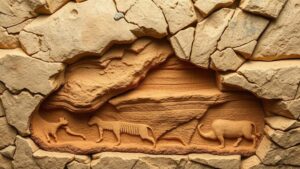Ancient Relics in the Rocks: Unearthing Trilobites in Fossil-Rich Beds
Ancient Relics in the Rocks: Unearthing Trilobites in Fossil-Rich Beds
Trilobites, the iconic arthropods of the ancient seas, have captivated rockhounds and mineral collectors for generations. With their distinctive exoskeletons and rich geological history, these fossils provide invaluable insights into the early development of marine ecosystems. This article delves into the world of trilobites, exploring their significance, where to find them, and tips for collectors.
The Significance of Trilobites
Trilobites thrived during the Paleozoic Era, approximately 521 to 252 million years ago, making them one of the earliest known complex life forms. e creatures inhabited a variety of marine environments and are classified into three main sections: the cephalon (head), thorax (body), and pygidium (tail). Over 20,000 species have been identified, showcasing a remarkable diversity in form and adaptation.
Trilobites are valuable to paleontologists for several reasons:
- They serve as index fossils, helping to date and correlate the ages of rock layers.
- Their varied forms illustrate evolutionary changes in response to environmental conditions.
- Studying trilobite fossils provides insights into ancient marine ecosystems, including predator-prey dynamics.
Where to Find Trilobite Fossils
Trilobites are predominantly found in sedimentary rock formations, particularly in regions that were once covered by ancient seas. Some of the most famous fossil-rich beds for trilobite hunting include:
- Devonian Deposits: The Catskill Formation in New York and the Ohio Shale are renowned for well-preserved specimens.
- Ordovician Layers: The Wheeler Formation in Utah and the Knox Group in the southeastern United States offer excellent trilobite finds.
- Cambrian Rocks: Locations like the Burgess Shale in Canada feature some of the oldest and most diverse trilobite fossils.
Each of these sites presents unique opportunities for discovery, with specific features that may favor fossil preservation. Collectors should always verify property rights and obtain necessary permits before excavating fossil sites.
Tips for Collectors
For rockhounds eager to delve into trilobite collecting, the following strategies can enhance the experience:
- Research: Prior to heading out, familiarize yourself with the geology of the area and types of trilobites you might find.
- Tools: Essential tools include chisels, hammers, safety goggles, and a sturdy backpack for carrying specimens.
- Observation: Inspect rock layers closely for natural fractures that may expose trilobite fossils, increasing your chances of a successful find.
Real-World Applications of Trilobite Fossils
The study of trilobites extends beyond simple collection; it has practical implications in various fields:
- Paleontology: Understanding the evolution and extinction events of trilobites can illuminate broader patterns in biodiversity and climate changes.
- Geology: Trilobites help geologists identify and correlate rock layers, aiding in oil exploration and resource management.
- Education: Trilobites serve as effective educational tools, allowing students to engage with paleontological principles through hands-on fossil hunting.
Conclusion: The Adventure of Collecting Trilobites
Unearthing trilobites from fossil-rich beds combines the thrill of discovery with the joy of connecting with ancient life forms. For dedicated rockhounds and mineral collectors, these fossils represent more than mere specimens; they offer a tangible link to Earths distant past. As you embark on this journey, remember to respect the environment, understand the importance of responsible collecting, and cherish each uncovering as a piece of history.
In summary, whether you are an experienced collector or just starting your journey into fossil hunting, trilobites present an exciting opportunity to explore the rich tapestry of life that once inhabited our planet’s oceans. Happy hunting!


